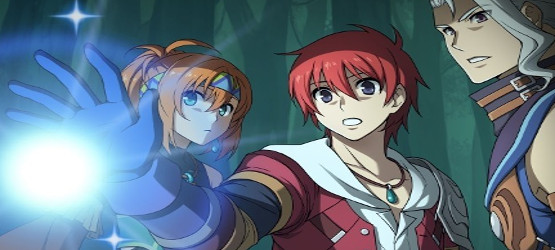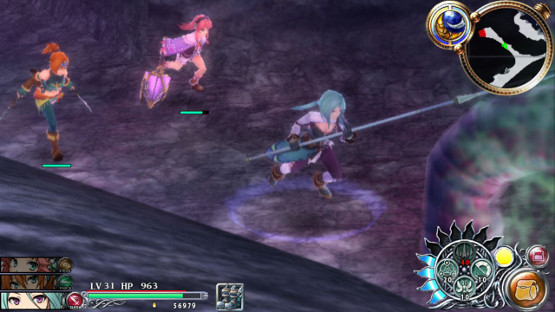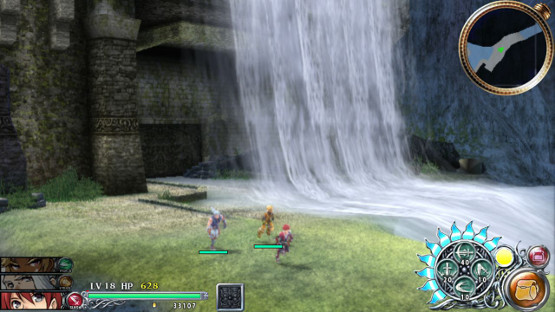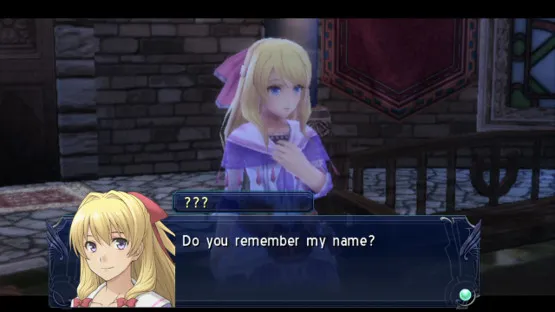Ys, pronounced “ease” for those less puntaculistic than myself; is a long-running series of action RPGs which feature lead swordsman Adol Christin delving into ancient ruins seeking adventure. Unlike the traditional yoke of RPG storytelling wherein a lucky power child or prophesized warrior is the sole hope for saving the world, Adol has made it his job to be the prophesized warrior saving the world. He has done this around seven times over. The situations he gets into are a byproduct of his love of adventure, desire to help others, and ability to kill whatever self-fashioned god is attempting to emerge using some forgotten leftover artifact.
The above is all the background any new player to the world of Ys needs. Each game outside of the first two is largely self-contained and Memories of Celceta is no exception. There are common elements across the series, such as the excellent battle systems, awesome boss fights, and fantastic music.
Fans returning to the series will notice the Celceta has almost the same battle system as Seven. It’s a fast-action battle system which relies on timing and dodging to get the utmost out of combat. Most of the time, players will be controlling the lead of three on-screen party members. Players can attack, guard or dash around enemies. There are skills available to use as players level up. The skills use the game’s version of MP called Skill Points or SP, which is replenished by attacking enemies. Skills are also able to level up. An EX gauge is also available, which unleashes a power attack on enemies. The EX gauge is replenished by using skills. As a result, combat flows easily into attacking enemies to regain skill points, which are then used to fill the EX gauge.
In addition to the above, there is also the Flash Guard and Flash Move. Guarding or dashing right before an enemy connects its attack activates these abilities. Flash Guard nullifies all damage, replenishes the SP and EX gauges a little, and allows critical hits for a second or two. Flash Move makes the party invincible for a second and slows down all enemies on the screen. These moves are not just extra fluff added to the battle system, but rather the core of the battle system towards the end of Normal mode and a necessity on the higher difficulties. Battles in Memories of Celceta can be won by button mashing on Normal or Easy difficulty, but players will require a ton of healing items to pull this off. Fighting effectively requires a combination of Flash skills and utilizing SP and EX attacks. Celceta is not an easy game once players make it more than 10 hours in. Enemies can be relentless and knock down players, and will keep hitting while they are down.
Players control the lead party member and the leader can be switched out between the three members onscreen with the touch of a button. Ai is well done as well. Occasionally players will get stuck behind something or run in circles for a second, but the game warps other party members next to the leader if too far away. And quite frankly, the AI guards and dodges attacks better than most players.
Six party members will be available by the end of the game, and switching out the three main members is easy to do. While the menu can be selected using the buttons, the Vita’s touchscreen really shines in regards to party management. It was easy to replace the whole party in e few touches and get right back to combat thanks to the front touchscreen. Time would actually be lost if the menu was navigated solely using buttons. The rear touchscreen has one function in Memories, as it allows players to switch between an attack or evade stance on the fly by moving fingers towards the center or outward. This was a little harder to pull off, yet still did not interrupt combat in the slightest. The touchscreen is not as useful for navigating the rest of the menus.
Boss battles change the dynamic of combat greatly due to the overwhelming size of the bosses. Regular enemies met while exploring can get pretty big, but are often easily dispatched. Bosses tend to take up large portions of the screen and often cover the available area with attacks. All enemies in the game tend to have ‘tells’ during fights. Boss fights consist of figuring out these tells during a frenetic swordfight with some awful hellspawn and figuring out when to dodge or use the Flash system. Many bosses can be dizzied so players get a moment to stand still, but for the most part constant movement is needed to not die. If regular enemies can get tough, bosses also huge jerks. it is not uncommon for bosses to juggle players or repeatedly beat them when knocked down; shaving off 80% of health in the process.
Most boss fights are not as memorable as previous installments of the Ys series. Many of the fights are similar, but there are a few which stand out. The final boss fight is truly remarkable – I was left in awe of what had transpired. This fight is what encompasses not only the feel of Ys as a series, but the battle system specifically used in Celceta. I am often reminded of people describing being “there” in a truly epic FPS firefight or a memorable match in a versus brawler; where the lines between player and character are diminished. In that last fight I was Adol and Adol was I, and it was fantastic.
This fight, as most others, was helped along greatly by the soundtrack. The fight tracks really push along the urgency of battle. The town and exploration tracks are catchy. Towards the end of the game the music really ramps up to deliver and enhance the last few dungeons and fights the game contains. There is spoken dialogue in the game as well. The voice actors have done a good job, but the spoken dialogue is sparse and frequently only used for character introductions.
World and dungeon designs are well done. Celceta and the lands it contains mesh into one another very well, with the actual forest areas of Celceta coming across as fantastic. There is a lot to explore as well, with rewards given as more of the world is explored. The world has lots of color and the Vita shows this off rather well. It’s a shame the character models are not on the same level as the background design. While the cutscenes and art found in the game are excellent, the in-game character models are average when viewed closely. This fact is inescapable in the game’s opening moments as players are treated to Adol’s awkward open eyes and odd posture as he lay on the ground too tired to move from his previous endeavor. Once combat and exploration ensue the focus on the character models is less apparent as the camera pulls back. Sadly, exploration is not smooth. Combat is unaffected, but running through the forest can be rough on the eyes as it skips and shudders a little.
Ys games have never been heavy on the plot, but Celceta picks up one of the more abused JRPG clichés as Adol is amnesiac following an excursion into the Celcetan Forest, an unmapped and dangerous sanctuary for all sorts of creatures. Well, no matter. There’s gold to be found in the forest, and the presiding town official is paying explorers to map the forest. What plays out is a largely predictable series of events. Adol’s recent past is hinted at by finding memories scattered throughout the land and watching the contents for clues. Eventually, the entire region needs saving and Adol and friends are just the people to do so. The game is rife with Deus ex Machina, which oddly makes sense since no one knows what is in the Celcetan Forest and much of the plot does involve a god-like being with actual god-like power. In fact, the Deus ex Machina aspects almost seem appropriate, though are still awkward.
Characterization also takes a slight hit. None of the party members ever really grow out of their assigned roles. Some of the NPCs show much more growth than party members. However, the interaction between members is still well above average and has a lot of fun moments. Instead, most of the characterization unusually focuses on Adol. A silent protagonist, Adol has much more to say in Celceta than most Ys games combined. Players are given actual responses to other characters; some of which are quite funny or sarcastic. While players delving into the world of Ys for the first time may not think much of Adol, the last memory played in the game still manages to shine a light on Adol’s overall character more accurately than the events of the rest of the game put together.
Beating Celceta unlocks New Game Plus, where players can run through the game with all of the non-plot related items they accrued in the first playthrough, including the ability to so on different difficulty levels. Once players take control of Adol the Time Attack mode becomes available. Time Attack sets the party against any boss in the game with set equipment and items in an attempt to defeat the boss as quickly as possible. Since Time Attack is available as soon as Adol is controllable, this means player can face all of the bosses in the game one on one if they desire. It’s pretty freaking sweet and showcases a bit of a different game if only Adol is used. It feels like previous Ys titles, actually.
For Ys fans, Celceta is not Adol’s greatest adventure. This is not to say the game is bad – Celceta’s slow open and initial lack of connection to other Ys titles until later in the game are just a little awkward to get used to in light of the stellar Ys: Seven, which managed to stand on its own despite forgoing many series standards. The ending is abrupt following the final battle as well, and will leave players wanting to know more. When Celceta finally manages to include itself into the overall Ys storyline, a sturdy bridge between Ys Origin, Ys I & II, and Ys VI is formed and the Ys world is ultimately better for it.
Even with the lackluster character models, lack of smooth scrolling and generic plot with its awkward moments; Ys: Memories of Celceta is still a blast to play. The combat system just blows most other concerns out of the way. The different difficulty levels help tailor gameplay to the individual, and a New Game Plus mode is always a great addition to any game. Action RPG fans have probably found one of the best available titles for the Vita, and Ys fans have another world to explore in Celceta.
*Review copy provided by Publisher
-
Combat is excellent; particularly the boss fights.
-
Music is great.
-
World looks amazing â lots of detail in the forest of Celceta.
-
Lots to explore and do as well.
-
Plot is generic with some awkward moments.
-
In-game character graphics are lackluster and exploration does not scroll smoothly all of the time.











